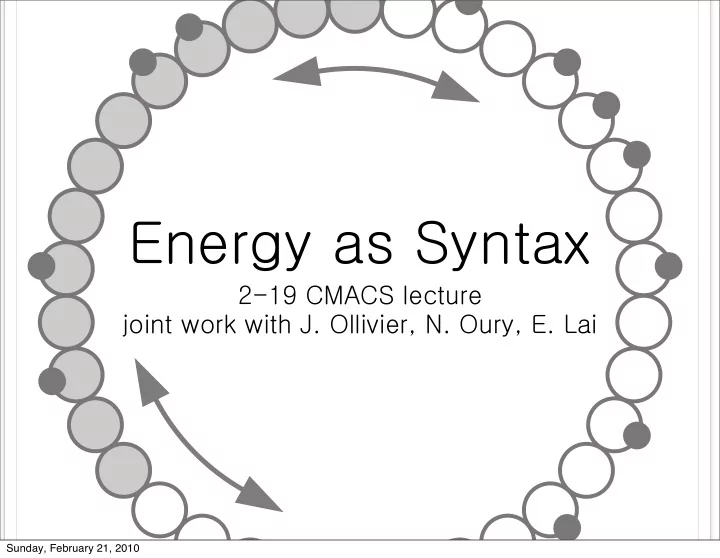

Energy as Syntax 2-19 CMACS lecture joint work with J. Ollivier, N. Oury, E. Lai Sunday, February 21, 2010
turbo introduction to Kappa/BNGL why rules are great Sunday, February 21, 2010
McBeath et al., Nature 2004 Sunday, February 21, 2010
Kim et al., Science 2006 Sunday, February 21, 2010
probabilistic (site) graph rewriting a pattern p p Y115 Y115 a rule A B A B s p s p A(s),B(p,Y115 p ) → A(s 1 ),B(p 1 ,Y115 p ) p Y115 p p B A s Y115 T708 q 1 n o t i c a e r p B p p A s a complex, u Y115 T708 T708 B q a molecular species p p p u Y115 A(s 1 ,q 2 ),B(p 1 ,Y115 p ,T708 p ),B(p 1 ,Y115 p ,T708 2 T708 B u ) reaction 2 p p Y115 p B A s T708 q p p u Y115 T708 B p Sunday, February 21, 2010
try Kappa! http://www.pps.jussieu.fr/~jkrivine/ binaires/Telechargements/ Outils_danalyses_et_de_simulation.html Sunday, February 21, 2010
forget about rules! Sunday, February 21, 2010
energy as syntax energy-oriented modelling/programming - more structured approach • as in structured programming • esp. well suited for combinatorial molecular network for which: • no structure means no analysis possible ... - more physically realistic - less parameter-hungry Sunday, February 21, 2010
example: an allosteric Ising model [Science - Feb 5 2010 ] Sunday, February 21, 2010
Sunday, February 21, 2010
an allosteric Ising model an allosteric model of the E. Coli flagellar switch (with ANC-style energy) - a ring of 2-state protomers P(f): [favoured] f=0=inactive (counter clockwise) [disfavoured] f=1=active (clockwise) - potential bindees CheY that favour f=1 Sunday, February 21, 2010
combinatorics & nn CheY(s~p) might bind any P, which means an astonishing ~ 10 20 different configurations (that is the number of species one would need in a species- centric approach) we are going to write the Hamiltonian/ energy of the system - a sum of 3 different contributions all terms are nn=nearest neighbour Sunday, February 21, 2010
Energy landscaping - i a P conformational term whereby it is said that P prefers conformation 0 E(P(f~0)) < E(P(f~1)) convention: lower energy = more favoured Sunday, February 21, 2010
Energy landscaping - ii a CheY-P binding term whereby we say that if bound to pho’ed CheY, P prefers conformation 1 E(P(f~0,s!1),CheY(s~p!1)) > E(P(f~0,s!1),CheY(s~p!1)) nb: this term overlaps with the first one E(P((f~0/1))) Sunday, February 21, 2010
Energy landscaping - iii an Ising penalty term for n.-neighbours not being in the same conformation which will "spread conformation" E(P(f~1,x!1),P(y!1,f~0)) = E(P(f~0,x!1),P(y!1,f~1)) > E(P(f~0,x!1),P(y!1,f~0)) = E(P(f~1,x!1),P(y!1,f~1)) Sunday, February 21, 2010
dynamics ii - rules # 10 reversible rules ## 2 binds ### P-CheY binding: CheY needs to be pho'ed & prefers conformation P(f~1) by a factor of 10 'bind 0' P(f~0,s), CheY(s~p) <-> P(f~0,s!1), CheY(s~p!1)@1,10 'bind 1' P(f~1,s), CheY(s~p) <-> P(f~1,s!1), CheY(s~p!1)@1,1 ## 8 flips (aka conformational change) ### 4 P flips without CheY - note that P(f~0) is favoured 2/1 'flip 000' P(f~0,y!1),P(x!1,f~0,y!2,s),P(x!2,f~0) <-> P(f~0,y!1),P(x!1,f~1,y!2,s),P(x!2,f~0)@1,200 'flip 100' P(f~1,y!1),P(x!1,f~0,y!2,s),P(x!2,f~0) <-> P(f~1,y!1),P(x!1,f~1,y!2,s),P(x!2,f~0)@1,2 'flip 001' P(f~0,y!1),P(x!1,f~0,y!2,s),P(x!2,f~1) <-> P(f~0,y!1),P(x!1,f~1,y!2,s),P(x!2,f~1)@1,2 'flip 101' P(f~1,y!1),P(x!1,f~0,y!2,s),P(x!2,f~1) <-> P(f~1,y!1),P(x!1,f~1,y!2,s),P(x!2,f~1)@100,2 ### 4 P flips with CheY - note that all forwards are multiplied by 10 (one simple way to satisfy the ANC ### thermodynamic constraint, aka the Wegscheider condition) 'flip 000b' P(f~0,y!1),P(x!1,f~0,y!2,s!_),P(x!2,f~0) <-> P(f~0,y!1),P(x!1,f~1,y!2,s!_),P(x!2,f~0)@10,200 'flip 100b' P(f~1,y!1),P(x!1,f~0,y!2,s!_),P(x!2,f~0) <-> P(f~1,y!1),P(x!1,f~1,y!2,s!_),P(x!2,f~0)@10,2 'flip 001b' P(f~0,y!1),P(x!1,f~0,y!2,s!_),P(x!2,f~1) <-> P(f~0,y!1),P(x!1,f~1,y!2,s!_),P(x!2,f~1)@10,2 'flip 101b' P(f~1,y!1),P(x!1,f~0,y!2,s!_),P(x!2,f~1) <-> P(f~1,y!1),P(x!1,f~1,y!2,s!_),P(x!2,f~1)@1000,2 Sunday, February 21, 2010
Sunday, February 21, 2010
conformation spread The lower curve - tracking the Ising energy of the ring stays low at all time - despite fraction of inactive P's ranging in [0,1] depending on nb of CheY-Ps NB: a Duke, Bray, Le Novere model; does not need a regular and/or permanent lattice Sunday, February 21, 2010
home run! - more physically realistic: seems to fit really well in this case (see Ref) - less parameter-frenzy: • 10 reversible rules • 8 energy terms = 2 flips + (2+4) binds • 16 independent choices of kinetic rates “time scales” - more structured approach: it really shines! - esp. well suited for combinatorial molecular networks: 10 20 ! Sunday, February 21, 2010
Recommend
More recommend